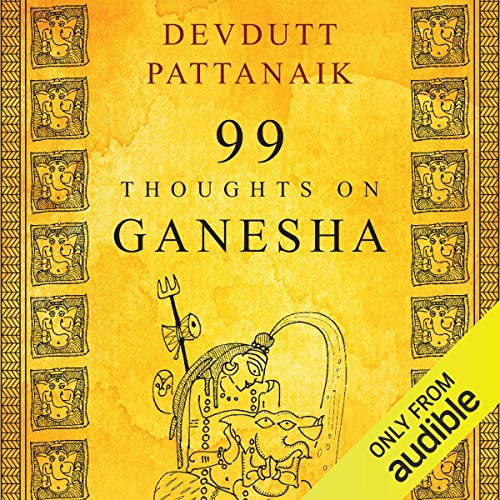Ganesh Chaturthi 2023: Discover lesser-known facts about Ganapati

Team L&M
Ganesh Chaturthi, alternatively referred to as Vinayak Chaturdashi is one of the most auspicious festivals celebrated across the country with great pomp and zeal. The son of Lord Shiva and Devi Parvati, whose form is highly alluring evokes devotion in the hearts of many. The multifaceted world of Ganesha is associated with several interpretations and implications. In his audiobook, 99 Thoughts on Ganesha on Audible. Devdutt Pattanaik unravels the layers of Ganesha’s symbolism, mythology, and significance, providing listeners with an in-depth understanding of this iconic deity and its relevance in contemporary life. This Ganesh Chaturthi, we have curated eight examples of the symbolism that Lord Ganesha is associated with.
The symbolism behind Ganesha’s appearance
Our exemplary ancestors showed us that there are two ways of life: a hermit who steps and contemplates life (Shiva) and the other is a householder who lives the worldly life and experiences all that life has to offer fearlessly as Shakti. Shiva had apprehensions about being a father and dealing with the trials and tribulations of worldly life. Shakti desires the complete opposite and from this churning tension between the two arises the birth of Ganesha. Lord Ganesha’s appearance reflects this dualism wherein the animal head represents material joys and the human body represents spiritual bliss.
The sacramental importance of the north in Sanatan Dharma
When Shiva instructs his ganas to replace the head of Shakti’s son Ganesha, he asks them to go to the north and bring the head of the first creature they encounter. The northern direction has always been auspicious in Sanatan Dharma as its direction is marked with the pole star, the one that does not move in the sky. Since the north is ruled by Kubera, the pot-bellied treasurer of the gods, this direction is associated with stability, stillness, immortality, and wisdom. In comparison, the South is ruled by Yama and is synonymous with instability and ignorance.
The contrasting purpose of worshipping Lord Ganesha and Karthikeya
The idol of Ganesha, characterized by its curved elephant trunk and prominent ears, brings prosperity and good fortune to those who worship him. In contrast, his brother Karthikeya was created outside his mother’s womb with the assistance of various divine beings including Agni (the fire god), Vaayu (the wind god), and Goddess Ganga, among others. In his final creation, Karthikeya was endowed with six heads and a spear. The two brothers represent opposite ends of the spectrum – Ganesha’s worship is associated with prosperity while Karthikeya’s reverence is believed to provide protection.
Riddhi and Siddi – The Wives of Ganesha
Brahma, also known as Prajapati is believed to be the father of all living creatures. He created two daughters – Siddhi and Riddhi. These daughters were given to Ganesha in marriage. The two wives of Ganesha embody the two things associated with worshipping him – prosperity and wisdom. They represent the key desires of man – wealth and wisdom, visualized in female forms.
Ganesha brings forth the prosperity of Lakshmi & Saraswati
Lakshmi is the Goddess associated with prosperity and Saraswati is the Goddess of wisdom. Each Goddess loves to enter the house where the other resides but never stay together for long. Lakshmi and Saraswati are also known as the quarreling sisters. This is symbolic of all the challenges that come with acquiring both wealth and wisdom. When there is wealth, there is constant bickering over money matters causing wisdom to perish, hence it is believed that one needs to pray to Ganesha to enjoy the benefits of both Goddesses together, seeking a harmonious balance between wealth and wisdom.
The eight avatars of Vignesh
In the Mudgala Purana, Ganesha takes eight forms to destroy eight demons, each demon representing a disruptive emotional state. Vakratunda (god with a curved trunk) rides a lion to kill Matsara’s demon of jealousy and Ekadanta (god with one tusk) rides a rat to kill Mada, the demon of vanity. Mahodara (god with a great belly) rides a rat to kill Moha, the demon of attachment and Gajanana (god with an elephant head) rides a rat to kill Lobha, the demon of greed. While Lambodara (god with a pot belly) rides a rat to kill Krodha, the demon of rage, Vikata (god with a deformed body) rides a peacock to overpower Kama, the lord of lust. Vighnaraja (master of obstacles) rides a serpent to kill Mama, the demon of self-indulgence and Dhumravarna on a rat (smoke-colored god) kills Ahamkara, the demon of arrogance.
How Ganesha became Vighnaharta
Ganesha images are often seen along with the Nava-Graha collective or the Sapta-Matrika collective. The Nava-Grahas are nine male deities that represent the nine celestial bodies that play a key role in astrology. Sapta-Matrikas are seven female deities who are associated with diseases that affect children causing fevers, pox infections, seizures, and more. Both these sets of deities can be malevolent. The alignment of the nine planets can bring bad luck into one’s life and the gaze of the seven goddesses can wreak havoc in a household. As Ganesha grew in popularity and moved from being a folk deity to a mainstream deity, he was called upon to mitigate the negative effects caused by the Nava-Grahas and the Sapta-Matrikas. Thus, he became the God who removed obstacles.
The religious significance of the color ‘red’
Ganesha is often visualized in red color. Red color is significant in Hinduism because it represents material reality as opposed to white color which represents spiritual reality. The goddess, in her virginal form, wears a red sari while in her maternal form wears a green sari, like the red earth before rains and the green earth after rains. Ganesha’s red color thus closely associates him with Shakti. It indicates he is fiery and energetic. This is why he is called Mangal Murti or the embodiment of auspiciousness, associated with the Mangal graha (Mars).


